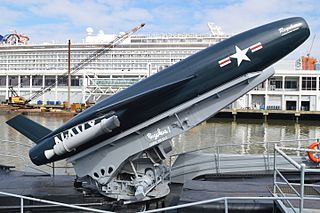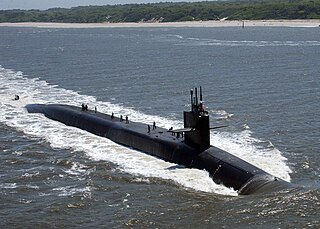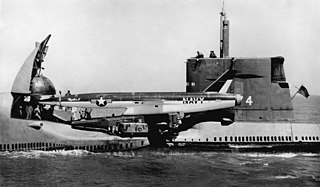
The Ohio class of nuclear-powered submarines includes the United States Navy's 14 ballistic missile submarines (SSBNs) and its four cruise missile submarines (SSGNs). Each displacing 18,750 tons submerged, the Ohio-class boats are the largest submarines ever built for the U.S. Navy. They are also the third-largest submarines ever built, behind the Russian Navy's Soviet era 48,000-ton Typhoon class, the last of which was retired in 2023, and 24,000-ton Borei class. Capable of carrying 24 Trident II missiles apiece, the Ohio class are equipped with just as many missiles as, if not more than, either the Borei class (16) or the deactivated Typhoon class (20).

A submarine-launched ballistic missile (SLBM) is a ballistic missile capable of being launched from submarines. Modern variants usually deliver multiple independently targetable reentry vehicles (MIRVs), each of which carries a nuclear warhead and allows a single launched missile to strike several targets. Submarine-launched ballistic missiles operate in a different way from submarine-launched cruise missiles.

The Oscar class, Soviet designations Project 949 Granit and Project 949A Antey, are a series of nuclear-powered cruise missile submarines designed in the Soviet Union for the Soviet Navy. First built in the 1970s, six remain in service with the Russian Navy. Two other vessels were slated to be modernized since at least 2017 as Project 949AM, to extend their service life and increase combat capabilities but it is unclear whether work continues as of 2023.

The SSM-N-8A Regulus or the Regulus I was a United States Navy-developed ship-and-submarine-launched, nuclear-capable turbojet-powered second generation cruise missile, deployed from 1955 to 1964. Its development was an outgrowth of U.S. Navy tests conducted with the German V-1 missile at Naval Air Station Point Mugu in California. Its barrel-shaped fuselage resembled that of numerous fighter aircraft designs of the era, but without a cockpit. Test articles of the Regulus were equipped with landing gear and could take off and land like an airplane. When the missiles were deployed they were launched from a rail launcher, and equipped with a pair of Aerojet JATO bottles on the aft end of the fuselage.
A ballistic missile submarine is a submarine capable of deploying submarine-launched ballistic missiles (SLBMs) with nuclear warheads. These submarines became a major weapon system in the Cold War because of their nuclear deterrence capability. They can fire missiles thousands of kilometers from their targets, and acoustic quieting makes them difficult to detect, thus making them a survivable deterrent in the event of a first strike and a key element of the mutual assured destruction policy of nuclear deterrence. The deployment of ballistic missile submarines is dominated by the United States and Russia. Smaller numbers are in service with France, the United Kingdom, China and India; North Korea is also suspected to have an experimental submarine that is diesel-electric powered.

The George Washington class was a class of nuclear-powered ballistic missile submarines deployed by the United States Navy. George Washington, along with the later Ethan Allen, Lafayette, James Madison, and Benjamin Franklin classes, comprised the "41 for Freedom" group of submarines that represented the Navy's main contribution to the nuclear deterrent force through the late 1980s.

41 for Freedom refers to the US Navy Fleet Ballistic Missile (FBM) submarines from the George Washington, Ethan Allen, Lafayette, James Madison, and Benjamin Franklin classes. All of these submarines were commissioned 1959–1967, as the goal was to create a credible, survivable sea-based deterrent as quickly as possible. These submarines were nicknamed "41 for Freedom" once the goal of 41 nuclear-powered ballistic missile submarines (SSBNs) was established in the early 1960s. The 1972 SALT I Treaty limited the number of American submarine-launched ballistic missile tubes to 656, based on the total missile tubes of the forty-one submarines, in line with the treaty's goal of limiting strategic nuclear weapons to the number already existing.

The Yankee class, Soviet designations Project 667A Navaga (navaga) and Project 667AU Nalim (burbot) for the basic Yankee-I, were a family of nuclear-powered ballistic missile submarines built in the Soviet Union for the Soviet Navy. In total, 34 units were built: 24 in Severodvinsk for the Northern Fleet and the remaining 10 in Komsomolsk-on-Amur for the Pacific Fleet. Two Northern Fleet units were later transferred to the Pacific.

USS Halibut (SSGN-587), a unique nuclear-powered guided missile submarine-turned-special operations platform, later redesignated as an attack submarine SSN-587, was the second ship of the United States Navy to be named after the halibut.

The Victor class, Soviet designations Project 671 Yorsh, Project 671RT Syomga and Project 671RTM/RTMK Shchuka,, are series of nuclear-powered attack submarines built in the Soviet Union and operated by the Soviet Navy. Since the 1960s, 48 units were built in total, of which the last remaining are currently in service with the Russian Navy. The Victor-class submarines featured a teardrop shape, allowing them to travel at high speed. These vessels were primarily designed to protect Soviet surface fleets and to attack American ballistic missile submarines. Project 671 began in 1959 with the design task assigned to SKB-143.

The Akula class, Soviet designation Project 971 Shchuka-B is a series of fourth generation nuclear-powered attack submarines (SSNs) first deployed by the Soviet Navy in 1986. There are four sub-classes or flights of Shchuka-B, consisting of the original seven Project 971 boats, commissioned between 1984 and 1990; six Project 971Is, commissioned between 1991 and 2009; one Project 971U, commissioned in 1995; and one Project 971M, commissioned in 2001. The Russians call all of the submarines Shchuka-B, regardless of modifications.

USS Florida (SSBN-728/SSGN-728), an Ohio-class cruise missile submarine, is the sixth vessel of the United States Navy to be named for the U.S. state of Florida. She was commissioned with the hull designation of SSBN-728; with her conversion to a cruise missile submarine, from a ballistic missile submarine, she was re-designated SSGN-728.

A submarine-launched cruise missile (SLCM) is a cruise missile that is launched from a submarine. Current versions are typically standoff weapons known as land-attack cruise missiles (LACMs), which are used to attack predetermined land targets with conventional or nuclear payloads. Anti-ship cruise missiles (ASCMs) are also used, and some submarine-launched cruise missiles have variants for both functions.

Project 629, also known by the NATO reporting name Golf, was a class of diesel-electric ballistic missile submarines that served in the Soviet Navy. All boats of this class had left Soviet service by 1990, and have since been disposed of. According to some sources, at least one Golf-class submarine was operated by China, to test new submarine-launched ballistic missiles (SLBMs).
There are three major types of submarines in the United States Navy: ballistic missile submarines, attack submarines, and cruise missile submarines. All submarines currently in the U.S. Navy are nuclear-powered. Ballistic missile submarines have a single strategic mission of carrying nuclear submarine-launched ballistic missiles. Attack submarines have several tactical missions, including sinking ships and subs, launching cruise missiles, and gathering intelligence. Cruise missile submarines perform many of the same missions as attack submarines, but with a focus on their ability to carry and launch larger quantities of cruise missiles than typical attack submarines.

The Delta class, Soviet designations Project 667B Murena, Project 667BD Murena-M, Project 667BDR Kalmar, Project 667BDRM Delfin, are a family of nuclear-powered ballistic missile submarines, designed and built in the Soviet Union, which formed the backbone of the Soviet and Russian strategic submarine fleet since their introduction in 1973. They carry nuclear ballistic missiles of the R-29 Vysota family, with the Delta I, Delta II, Delta III and Delta IV classes carrying the R-29/SS-N-8 'Sawfly', R-29D/SS-N-8 'Sawfly', R-29R/SS-N-18 'Stingray' and R-29RM/SS-N-23 'Skiff' respectively.

The Project 670 Skat submarine was a nuclear-powered cruise missile submarine built for the Soviet Navy and later operated by the Russian Navy. All Charlie I/II-class submarines are decommissioned. One Charlie-class submarine was used for testing an Oniks missile. Charlie I and its successor Charlie II-class submarines are designed by the Lazurit Central Design Bureau of Gorky.

The Grayback-class submarine was a class of two guided missile-carrying submarines of the United States Navy. They carried the Regulus I and Regulus II nuclear cruise missiles, deployed 1957–64, that were rapidly phased out by Polaris Submarine Launched Ballistic Missiles (SLBMs). They and USS Halibut were the sole submarines designed specifically to carry Regulus missiles, and the only submarines capable of carrying Regulus II. However, USS Tunny and USS Barbero were modified earlier to carry two Regulus I missiles per boat.

K-114 Tula is a Project 667BDRM Delfin-class nuclear-powered ballistic missile submarine (SSBN). As such, she carries a complement of R-29RM Shtil and R-29RMU Sineva nuclear submarine-launched ballistic missiles (SLBM) as her primary deterrent mission, along with anti-ship missiles and torpedoes, the latter for self-defense. Built in Severodvinsk during the late 1980s, she served with the Soviet Navy before being transferred to the Russian Navy following the dissolution of the Soviet Union. Tula underwent an extensive overhaul during 2000–2004 and was fitted with upgraded Shtil SLBMs, several of which were launched from her during her later operational life. She was sponsored by the city of Tula, and is homeported in Gadzhiyevo.

The Regulus missile submarines were a group of submarines operated by the United States Navy capable of carrying the Regulus cruise missile. Between 1959 and 1964, a total of five boats were used to undertake the first submarine-based nuclear deterrent patrols by the United States. Regulus submarines were used for this task until 1964, when sufficient ballistic missile submarines carrying the Polaris ballistic missile became available.
































